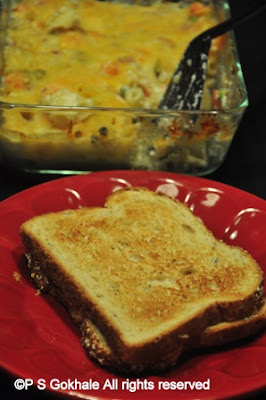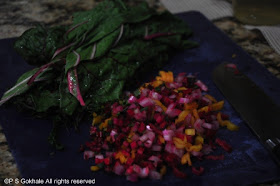Over the last two years (ever since I started blogging), I have collected many pictures of food. I cook everyday and enjoy trying out new recipes. So, it follows that I end up taking pictures at least a couple of days a week, of new food items and my photo collection keeps growing. The challenge is to keep up with the blog updates as I make new dishes. I was going through the various pictures and trying to decide which recipe to write up next, when I came across pictures of my homemade pineapple jam. It is an easy recipe, to make and to write up too, so it is the perfect choice for blogging on a rather busy day. I had used a method similar to my strawberry jam. It tastes delicious. It has a slightly tangy taste depending on how sour the pineapple is. It is a great accompaniment for bread or hot chapatis.
Ingredients
1 pineapple, finely chopped or grated or coarsely pureeed
sugar (about 1.5 to 2 cups) - quantity will depend on the cooked down quantity of the pineapple
1/8 tsp citric acid
Method
Cook the pineapple on medium heat. You will know that the pineapple is cooked once the color starts to become darker and the puree starts to thicken. At this stage, measure the amount of the cooked puree. Measure out two times the sugar compared to the quantity of cooked puree. I had one cup of the cooked puree and so I took two cups of sugar. Mix the puree and the sugar and heat it on a low flame. The mixture will become watery as the sugar melts and then start to thicken. When this mixture is thick enough where your spoon leaves a slight path when its dragged through it, it is ready to be taken off the heat. Take a little mixture in a small bowl and add the citric acid to it, stir thoroughly so that the citric acid is completely dissolved. Add this back to the warm mixture. Let it cool. Do not cover the jam as it cools down. Store it in the fridge upon cooling.
Tips
If you puree the pineapple, keep aside a slice of pineapple and cut it into fine pieces. The puree and pineapple pieces will provide the best texture for the jam. Store it in the fridge. Use only dry spoons when scooping the jam out of the container. Introduction of moisture will speed up the spoilage and it will not last for too long.
Ingredients
1 pineapple, finely chopped or grated or coarsely pureeed
sugar (about 1.5 to 2 cups) - quantity will depend on the cooked down quantity of the pineapple
1/8 tsp citric acid
Method
Cook the pineapple on medium heat. You will know that the pineapple is cooked once the color starts to become darker and the puree starts to thicken. At this stage, measure the amount of the cooked puree. Measure out two times the sugar compared to the quantity of cooked puree. I had one cup of the cooked puree and so I took two cups of sugar. Mix the puree and the sugar and heat it on a low flame. The mixture will become watery as the sugar melts and then start to thicken. When this mixture is thick enough where your spoon leaves a slight path when its dragged through it, it is ready to be taken off the heat. Take a little mixture in a small bowl and add the citric acid to it, stir thoroughly so that the citric acid is completely dissolved. Add this back to the warm mixture. Let it cool. Do not cover the jam as it cools down. Store it in the fridge upon cooling.
Tips
If you puree the pineapple, keep aside a slice of pineapple and cut it into fine pieces. The puree and pineapple pieces will provide the best texture for the jam. Store it in the fridge. Use only dry spoons when scooping the jam out of the container. Introduction of moisture will speed up the spoilage and it will not last for too long.




































